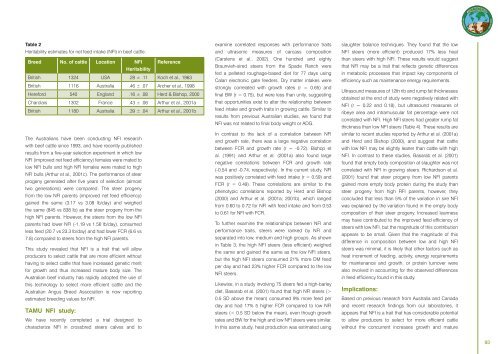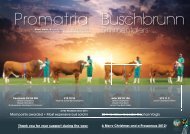Simmentaler Joernaal 2013.indb
Simmentaler Joernaal 2013.indb
Simmentaler Joernaal 2013.indb
You also want an ePaper? Increase the reach of your titles
YUMPU automatically turns print PDFs into web optimized ePapers that Google loves.
Table 2<br />
Heritability estimates for net feed intake (NFI) in beef cattle.<br />
Breed No. of cattle Location NFI<br />
Heritability<br />
The Australians have been conducting NFI research<br />
with beef cattle since 1993, and have recently published<br />
results from a five-year selection experiment in which low<br />
NFI (improved net feed efficiency) females were mated to<br />
low NFI bulls and high NFI females were mated to high<br />
NFI bulls (Arthur et al., 2001c). The performance of steer<br />
progeny generated after five years of selection (almost<br />
two generations) were compared. The steer progeny<br />
from the low NFI parents (improved net feed efficiency)<br />
gained the same (3.17 vs 3.08 lb/day) and weighed<br />
the same (845 vs 838 lb) as the steer progeny from the<br />
high NFI parents. However, the steers from the low NFI<br />
parents had lower NFI (-1.19 vs 1.56 lb/day), consumed<br />
less feed (20.7 vs 23.3 lb/day) and had lower FCR (6.6 vs<br />
7.8) compared to steers from the high NFI parents.<br />
This study revealed that NFI is a trait that will allow<br />
producers to select cattle that are more efficient without<br />
having to select cattle that have increased genetic merit<br />
for growth and thus increased mature body size. The<br />
Australian beef industry has rapidly adopted the use of<br />
this technology to select more efficient cattle and the<br />
Australian Angus Breed Association is now reporting<br />
estimated breeding values for NFI.<br />
TAMU NFI study:<br />
We have recently completed a trial designed to<br />
characterize NFI in crossbred steers calves and to<br />
Reference<br />
British 1324 USA .28 ± .11 Koch et al., 1963<br />
British 1116 Australia .46 ± .07 Archer et al., 1998<br />
Hereford 540 England .16 ± .08 Herd & Bishop, 2000<br />
Charolais 1302 France .43 ± .06 Arthur et al., 2001a<br />
British 1180 Australia .39 ± .04 Arthur et al., 2001b<br />
examine correlated responses with performance traits<br />
and ultrasonic measures of carcass composition<br />
(Carstens et al., 2002). One hundred and eighty<br />
Braunvieh-sired steers from the Spade Ranch were<br />
fed a pelleted roughage-based diet for 77 days using<br />
Calan electronic gate feeders. Dry matter intakes were<br />
strongly correlated with growth rates (r = 0.65) and<br />
final BW (r = 0.75), but were less than unity, suggesting<br />
that opportunities exist to alter the relationship between<br />
feed intake and growth traits in growing cattle. Similar to<br />
results from previous Australian studies, we found that<br />
NFI was not related to final body weight or ADG.<br />
In contrast to the lack of a correlation between NFI<br />
and growth rate, there was a large negative correlation<br />
between FCR and growth rate (r = -0.72). Bishop et<br />
al. (1991) and Arthur et al. (2001a) also found large<br />
negative correlations between FCR and growth rate<br />
(-0.54 and -0.74, respectively). In the current study, NFI<br />
was positively correlated with feed intake (r = 0.59) and<br />
FCR (r = 0.49). These correlations are similar to the<br />
phenotypic correlations reported by Herd and Bishop<br />
(2000) and Arthur et al. (2001a; 2001b), which ranged<br />
from 0.60 to 0.72 for NFI with feed intake and from 0.53<br />
to 0.61 for NFI with FCR.<br />
To further examine the relationships between NFI and<br />
performance traits, steers were ranked by NFI and<br />
separated into low, medium and high groups. As shown<br />
in Table 3, the high NFI steers (less efficient) weighed<br />
the same and gained the same as the low NFI steers,<br />
but the high NFI steers consumed 21% more DM feed<br />
per day and had 23% higher FCR compared to the low<br />
NFI steers.<br />
Likewise, in a study involving 75 steers fed a high-barley<br />
diet, Basarab et al. (2001) found that high NFI steers (><br />
0.5 SD above the mean) consumed 9% more feed per<br />
day and had 17% 5 higher FCR compared to low NFI<br />
steers (< 0.5 SD below the mean), even though growth<br />
rates and BW for the high and low NFI steers were similar.<br />
In this same study, heat production was estimated using<br />
slaughter balance techniques. They found that the low<br />
NFI steers (more efficient) produced 17% less heat<br />
than steers with high NFI. These results would suggest<br />
that NFI may be a trait that reflects genetic differences<br />
in metabolic processes that impact key components of<br />
efficiency such as maintenance energy requirements.<br />
Ultrasound measures of 12th rib and rump fat thicknesses<br />
obtained at the end of study were negatively related with<br />
NFI (r = 0.22 and 0.18), but ultrasound measures of<br />
ribeye area and intramuscular fat percentage were not<br />
correlated with NFI. High NFI steers had greater rump fat<br />
thickness than low NFI steers (Table 4). These results are<br />
similar to recent studies reported by Arthur et al. (2001a)<br />
and Herd and Bishop (2000), and suggest that cattle<br />
with low NFI may be slightly leaner than cattle with high<br />
NFI. In contrast to these studies, Basarab et al. (2001)<br />
found that empty body composition at slaughter was not<br />
correlated with NFI in growing steers. Richardson et al.<br />
(2001) found that steer progeny from low NFI parents<br />
gained more empty body protein during the study than<br />
steer progeny from high RFI parents, however, they<br />
concluded that less than 5% of the variation in sire NFI<br />
was explained by the variation found in the empty body<br />
composition of their steer progeny. Increased leanness<br />
may have contributed to the improved feed efficiency of<br />
steers with low NFI, but the magnitude of this contribution<br />
appears to be small. Given that the magnitude of this<br />
difference in composition between low and high NFI<br />
steers was minimal, it is likely that other factors such as<br />
heat increment of feeding, activity, energy requirements<br />
for maintenance and growth, or protein turnover were<br />
also involved in accounting for the observed differences<br />
in feed efficiency found in this study.<br />
Implications:<br />
Based on previous research from Australia and Canada<br />
and recent research findings from our laboratories, it<br />
appears that NFI is a trait that has considerable potential<br />
to allow producers to select for more efficient cattle<br />
without the concurrent increases growth and mature<br />
93



